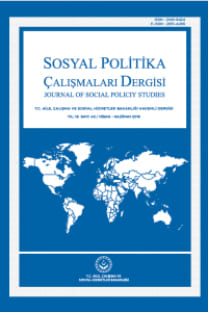SOSYAL BASKINLIK YÖNELİMİ VE EMPATİNİN SURİYELİ SIĞINMACILARIN TEHDİT OLARAK ALGILANMASI İLE İLİŞKİLERİ: ÇANKAYA VE ALTINDAĞ ÖRNEKLERİYLE BİR YAPISAL EŞİTLİK MODELİ
Suriyeliler 2011 yılından beri Suriye’deki savaş ortamından dolayı ülkelerini terk etmek ve başta komşu ülkeleri Türkiye, Ürdün ve Lübnan olmak üzere farklı ülkelere sığınmak zorunda kalmışlardır. Türkiye’de 2018 yılında 3,6 milyonunun üzerinde geçici koruma altında olan Suriyeli yaşamaktadır. Bu çalışmada Ankara’da Suriyeli göçmen sayısının yoğun olduğu Altındağ ve az olduğu Çankaya ilçelerinde yerel halkın endeksler aracılığıyla Suriyelilere ilişkin algıları ölçülmüştür. Araştırma kapsamındaki bu iki ilçede yaşayan 818 kişi ile yapılan anket çalışmasında sosyal baskınlık yönelimi, empati ve tehdit ölçmek üzere beşli likert ölçeklerden oluşan nicel veri elde edilmiştir. İlgili veride sosyal baskınlık, sosyal eşitlik, empati, sosyoekonomik tehdit ve politik tehdit olarak elde edilen değişkenler ile yapısal eşitlik modellemesi yapılarak ölçeklere ilişkin kurulan altı hipotez test edilmiştir. Kişilerin sosyal baskınlık ve sosyal eşitlik alt boyutlarıyla sosyal baskınlık yönelimleri ve empatilerinin Suriyeli sığınmacıların sosyoekonomik tehdit ve politik tehdit olarak algılanmaları ile etkileşimi her iki ilçe için Gruplararası Temas Kuramı ve Birleşik Tehdit Kuramı gibi ilgili kuramlar temelinde karşılaştırmalı analiz edilmiştir.
Anahtar Kelimeler:
Sosyal Baskınlık Yönelimi, Empati, Tehdit, Yapısal Eşitlik Modellemesi, Algı, Mülteciler
RELATIONSHIPS OF SOCIAL DOMINANCE ORIENTATION AND EMPATHY WITH PERCEPTION OF SYRIAN REFUGEES AS THREAT: STRUCTURAL EQUATION MODELING WITH THE EXAMPLES OF ÇANKAYA AND ALTINDAĞ
Syrians have been obligated to leave their country and seek to asylum to the different countries mainly their neighbor countries; Turkey, Jordan and Lebanon. At the year of 2018, over 3,6 million Syrians live under temporary protection in Turkey In this study, perceptions towards Syrian refugees in Ankara were measured by means of the indexes of local people in Altındağ district where Syrians are populated to a high degree and Çankaya district where Syrian are populated to a low degree. Based on the questionnaire survey with 818 people living in these two districts, quantitative data of five-point likert scales were obtained to measure social dominance orientation, empathy and threat. Six hypotheses are tested by structural equation modeling with attained variables as social dominance, social egalitarianism, empathy, socioeconomic threat and politic threat in the related data. Based on the related theories, mainly Intergroup Contact Theory and Integrated Threat Theory, interactions of sub-dimensions of social dominance orientation (social dominance and social egalitarianism) and empathy with the perception towards Syrian refugees (socioeconomic threat and political threat) are analyzed comparatively for both districts.
Keywords:
social dominance orientation, empathy, threat, structural equation modeling, perception, refugees,
___
- Akbaş, G. (2010). Social Identity and Intergroup Relations: The Case of Alevis and Sunnis in Amasya. (Yüksek Lisans Tezi). O.D.T.Ü. Sosyal Bilimler Enstitüsü, Ankara.Bash, H., H. (2014). Dominant Group, Salem Press Encyclopedia.Byrne, B., M. (2008). Structural Equation Modelling with EQS: basic concepts, applications and programming, Routledge, New York.Davis, M., H. (1983). Measuring Individual Differences in Empathy:Evidence for a Multidimensional Approach, Journal of Personality and Social Psychology, 44(1), 113-126.Eroğlu, D., Cohen, J. H. ve Sirkeci, İ. (2016). Turkish Migration Selected Papers(Migration Series). 1. Baskı. London: Transnational Press London.Fultz, J. ve Schafer, E., D. (2013). Alturism, Cooperation adn Empathy, Salem Press Encyclopedia of Hea.Göç İdaresi Genel Müdürlüğü (GİGM). (2016).Göç İdaresi Genel Müdürlüğü (GİGM). (2018). Geçici Koruma İstatistikleri. http://www.goc.gov.tr/icerik6/gecici-koruma_363_378_4713_icerik Erişim tarihi:15.05.2018 veri yayın tarihi: 10.05.2018Hogan, R. (1969).Development of an Empathy Scale, Journal of Consulting and Clinical Psychology, 33(3), 307-316.Jost, J., T. Ve Thompson, E., P. (2000). A Measure of Emotional Empathy, Journal of Experimental Social Psychology, 36, 209-232.Kalaycı, Ş., (2006). SPSS Uygulamalı Çok değişkenli İstatistik Teknikleri, Asil Yayın Dağıtım Ltd. Şti., Ankara.Mehrabian, A., ve Epstein N., (1972). A Measure of Emotional Empathy, Journal of Personality, 40(4), 525-543.Meydan, C., H. ve Şeşen, H. (2015). Yapısal Eşitlik Modellemesi Amos Uygulamaları, Detay Yayıncılık, Ankara.Pratto, F., Sidanius, J. Ve Levin, S. (2006). Social Dominance Theory and Dynamics of Intergroup relations: Taking Stock and Looking Forward: A Multidisciplanary Journal, 17, 271-320.Schumacker, R., E., Lomax, R., G. (2004). A Beginner’s Guide to Structural Equation Modelling, Lawrance Erlbaum Associates, New Jersey. Sidanius, J., Cling, B., J., ve Pratto, F. (1991). Ranking and Linking as a Function of Sex and Gender Role Attitudes, Journal Social Issues, 47(3), 131-149.Spreng, R., N., G., Mckinnon, M., C., Mar, R., A. ve Levine, B. (2009). The Toronto Empathy Questionnare: Scale Development and Initial Validation of a Factor-Analytic Solution to Multiple Empathy Measures, Journal of Personality Assement, 91(1), 62-71.Stephan, W., G., Ybarra, O. ve Bachman, G. (1999). Prejudice Towards Immigrants, Journal of Applied Social Psychology, 29(11), 2221-2237.
- ISSN: 2148-9424
- Yayın Aralığı: Yılda 4 Sayı
- Başlangıç: 2012
- Yayıncı: Aile,Çalışma ve Sosyal Hizmetler Bakanlığı
Sayıdaki Diğer Makaleler
SINIRIN YASAL “KAÇAK”LARI: MAKEDONYALI KAÇAK GELİNLER
MÜLTECİ ENTEGRASYONU, GÖÇ POLİTİKALARI VE SOSYAL SINIF: TÜRKİYE’DEKİ SURİYELİ MÜLTECİLER ÖRNEĞİ
“SURİYELİLER” HAKKINDA YAPILAN LİSANSÜSTÜ TEZLER ÜZERİNE BİR İNCELEME
GÖÇ YAŞANTISI ÇERÇEVESİNDE ÇOCUKTA PSİKO-SOSYAL UYUM SÜRECİ ÜZERİNE BİR İNCELEME
Selin Cennet GÜLMEZ, Ahu ÖZTÜRK
VAN YÜZÜNCÜ YIL ÜNİVERSİTESİ’NDEKİ SURİYELİ ÖĞRENCİLERİN AKADEMİK SORUNLARI ÜZERİNE BİR ÇALIŞMA
Aysun YARALI AKKAYA, Gülcan AZİMLİ ÇİLİNGİR, Gaye TUĞ LEVENT
Hüseyin Buğra KARAMAN, Sefa BULUT
ALMANYA’DA ÇOCUKLARI KORUMA ALTINA ALINAN GÖÇMEN AİLELERİN, GENÇLİK DAİRELERİNE İLİŞKİN DENEYİMLERİ
